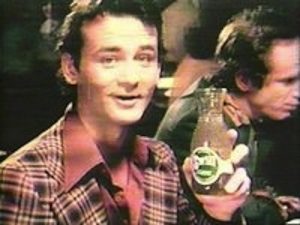Deborah Blum, one of my favorite writers, writes in National Geographic that ketchup—that cheerful red sauce sold in handy glass bottles—first came on the American market in the 19th century. But its ingredients were shockingly different than they are today.
 Food advocates complained that the sauce was frequently made from tomato scraps thickened with ground pumpkin rinds, apple pomace (the skin, pulp, seeds, and stems left after the fruit was pressed for juice), or cornstarch, and dyed a deceptive red. One French cookbook author described the ketchup sold in markets as “filthy, decomposed and putrid.”
Food advocates complained that the sauce was frequently made from tomato scraps thickened with ground pumpkin rinds, apple pomace (the skin, pulp, seeds, and stems left after the fruit was pressed for juice), or cornstarch, and dyed a deceptive red. One French cookbook author described the ketchup sold in markets as “filthy, decomposed and putrid.”
By the late 19th century, it would become less putrid, as manufacturers added chemical preservatives to slow decomposition in the bottle. But the real change—the invention of modern ketchup—occurred in the 20th century, and it’s a story of both politics and personality. It begins with an unlikely alliance between one of the country’s richest food manufacturers, Henry J. Heinz, and an underpaid federal chemist. The two men bonded over a mutual belief that unsafe and untrustworthy food was a growing national problem.
Harvey Washington Wiley’s position on the matter surprised no one. As chief of the U.S. Department of Agriculture’s chemistry bureau, Wiley had been pushing for food safety standards since the 1880s. At that time, his tiny department was the only federal division responsible for the country’s food quality. His chemists had exposed both widespread fraud—from gypsum in flour to brick dust in cinnamon—and a dismayingly reckless use of untested preservatives, ranging from formaldehyde to borax.
Heinz’s stance was a shock, especially to his fellow industrialists. He refused to fall in line with other US corporations, which were mostly moving to block any effort to establish food and drink standards. And to understand that, we need to take a look at the man himself as well as the successful businessman.
He was born in 1844 in Pittsburgh, the son of German immigrant parents. His parents, John and Anna Margaretha, were devout Lutherans; their children—Henry was the oldest of eight—were educated at a Lutheran school. Their mother insisted they live by Christian principles: “Do all the good you can. Do not live for yourself,” was one of her favourite sayings. It was also expected that the children would work hard and make a good living. That went without saying.
 As a child Henry sold extra vegetables from the family’s kitchen garden to neighbours; by age ten he had his own garden and carried produce by wagon to local grocers. By the time he was a teen, he was delivering produce to the grocers by horse cart and also selling prepared horseradish in small glass jars. Many commercial varieties were sold then in coloured glass—sometimes for decorative purposes, sometimes because it obscured the contents. Young Heinz deliberately used clear glass so that customers could see the horseradish inside. By 1888, at age 44, he had his own food manufacturing business, the H.J. Heinz Company, and from there he never looked back.
As a child Henry sold extra vegetables from the family’s kitchen garden to neighbours; by age ten he had his own garden and carried produce by wagon to local grocers. By the time he was a teen, he was delivering produce to the grocers by horse cart and also selling prepared horseradish in small glass jars. Many commercial varieties were sold then in coloured glass—sometimes for decorative purposes, sometimes because it obscured the contents. Young Heinz deliberately used clear glass so that customers could see the horseradish inside. By 1888, at age 44, he had his own food manufacturing business, the H.J. Heinz Company, and from there he never looked back.
Heinz’s company made some 60 products in 1896—and that would rise to 200 by the turn of the century. The company still offered horseradish but also pickles, ketchup, vinegars, chilli sauces, tomato sauce, mincemeat, fruit butters, baked beans, preserved cherries, mustard dressings, currant jelly, pineapple preserves, an assortment of mustards, canned pastas. Heinz was a master promoter—the company used everything from lighted billboards to painted wagons to displays at World Fairs to advertise its products.
But Heinz also believed that for promotion to succeed, the product itself had to be good, the manufacturer trustworthy. He allowed public tours of his Pittsburgh factory so that people could admire its cleanliness and well-treated workers. He built greenhouses to experiment with the best varieties of fruits and vegetables. He continued to use clear glass, rather than coloured, for his products. For his ketchup, he created one with an eight-sided base so customers could study the sauce from many angles.
And it was ketchup itself that would inspire him to go even further. …
In June 1906 the first two pieces of major consumer protection legislation in the United States—the Meat Inspection Act and the Pure Food and Drug Act—became law, laying the foundation for federal safety regulations.
And H.J. Heinz’s new, preservative-free ketchup was ready to go. As the company’s advertising campaign proclaimed, it was “recognised as the standard by Government pure food authorities.” It was also the new model for American ketchup—a thick mixture of politics, personality, a 20th-century acceptance that food safety matters, and of course, tomatoes.
Pulitzer Prize-winning journalist Deborah Blum is director of the Knight Science Journalism Program at MIT. Her books include The Monkey Wars and her latest, The Poison Squad.
